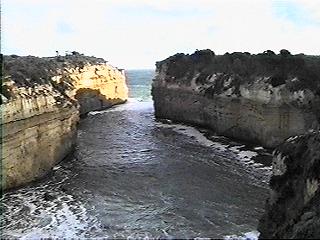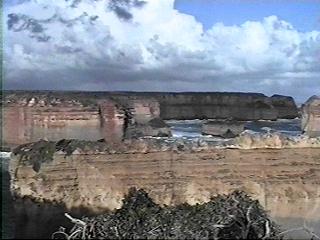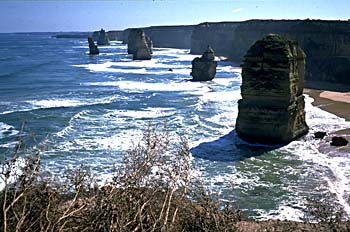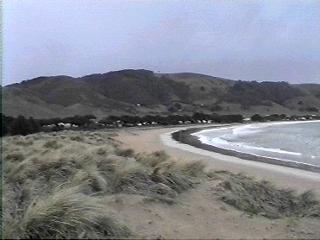|
BACKPACKERS
GUIDE TO AUSTRALIA
GREAT OCEAN ROAD
|
AUSTRALIA >VICTORIA
> GREAT OCEAN ROAD
Picture: 12 Apostles at sunset,
Port Campbell National Park, Great Ocean Road |
INTRODUCTION
The Great Ocean road runs 300 kilometres from Torquay to Warrnambool.
It is a rugged coastline with spectacular eroded clifflines and rock formations.
The Great Ocean Road is most spectacular towards its western end around
the tiny secluded seaside town of Port Campbell. Along this section
of the coast sheer sandstone cliffs drop 30m into the ocean. In Port Campbell
National Park, the Twelve Apostles and Loch Ard Gorge are to be found amoung
other eroded rock formations created by the force of the pounding oceans
over thousands of years. The coast has earnt the repuation as the shipwreck
coast with over 100 ships carrying settlers to Australia wrecked against
its eroded cliffline in often treacherous weather.
On the Surf Coast, where the cliffs recede at the eastern end
of the Great Ocean Road, are some excellent surf beaches. Bells Beach
is the best known as it hosts an international surf carnival.
Lorne, Anglesea and the smaller Apollo Bay are
three beachside tourist towns along the Great Ocean Road also with some
surf beaches. They get very crowded on weekends in summer with families
from from the nearby large city of Melbourne. |
PAGE INDEX
Introduction
Organised Tours
Attractions
Getting There & Away
Sightseeing
Getting Around
Surfing
Where to Go Next
 Picture: Loch Ard Gorge,
Port Campbell National Park
Picture: Loch Ard Gorge,
Port Campbell National Park

Picture: Shipwreck Coast,
Port Campbell National Park
|
|
|
| ATTRACTIONS
Sightseeing
This guide points out attractions on the Great Ocean Road from east
to west.
From Anglesea through Lorne to Appllo Bay the road
hugs the steep granite hills descending into the sea. Numerous holiday
houses line the coast. Beyond Apollo Bay the road goes inland through dense
fern forests of the Cape Otway National Park. (There are also fern
forests in the hills behind Lorne and Apollo bay).A 20 kilometre long gravel
sideroad leads to the Cape Otway Lighthouse, the second most southerly
point on mainland Australia.
The road eventually returns to the coast in Port Campbell National
Park where 30 metre high cliffs decsend straight into the sea. The
coast is indented from the waves cutting into the soft sandstone cliffs
leaving spectacular rock formations.
The Tweleve Apostles are stone pillars proruding from the sea
and the most famous rock formation along the coast. Gibsons Steps, 500m
east of the Twelve Apostles, lead down the side of the cliff to the beach
at the bottom of the Apostles.
|
 Picture: Twelve Apostles,
Port Campbell National Park
Picture: Twelve Apostles,
Port Campbell National Park

Picture: Apollo Bay
|
Loch Ard Gorge is also spectacular and has an interesting
history about shipwreck survivors.
There are several other caostal rock formations signposted along the
road.
Port Campbell, in the middle of the national park, is a picturesque
fishing village. Boat tours of the Apostles are available from here.
The road continues on to just before the large town of Warrnambool.
Here the Flagstaff Hill Maratime Village tells of the history of
the coast.
Touring by car the coast takes at least one day from Melbourne and staying
the following night in Warrnambool. |
| Surfing
The Surf Coast has great surf beaches, especially around Torquay.
Bells Beach is world famous because of an annual surf competition,
but Jan Jac is reliably the better surf beach. Both beaches are
near Torquay.
Anglesea, Lorne and Apollo Bay have surf beaches. Surf beaches further
west are isolated and very dangerous with strong undertoe. |

Picture: Surfing at the world
famous Bells Beach, near
Torquay, Surf Coast |
|
|
| ORGANISED
TOURS
One day bus trips are available from Melbourne returning late in evening.
Most tour bus operators are located on the east side of Swanston Street
bewteen Bourke and Lonsdale Streets.
Australian Pacific Tours 184 Swanston St Melbourne departs 8.45am
returning 9.30pm. Cost $88 ($50 if a YHA backpacker). Hotel/Hostel pickup
generally available. www.atie.com.au/tours/auspac
Boat tours of the Twelve Apostles are available from Port Campbell pier
(Port Campbell is very small and the pier easy to see. It is on the eastern
side of the cove).
|
|
| GETTING
THERE AND AWAY
By Car
From Melbourne drive 75 kilometres southwest to Geelong, then 30 kilometres
south to Anglesea at the eastern end of the Great Ocean Road. This takes
90 minutes. Allow 2 days for a round trip from Melbourne or one very very
long and somewhat rushed day.
Public transport to the Great Ocean Road is almost non-existant. Local
buses run irregularly between Geelong and Anglesea. A far better option
is to take a one day bus tour from Melbourne (see Organised Tours
above).
|
|
| GETTING
AROUND
By Car
By car the Great Ocean Road can be explored in one long day.
Public transport along the Great Ocean Road is almost non-existant.
Local buses run irregularly between Geelong, Anglesea, Lorne and Apollo
Bay. A far better option is to take a one day bus tour from Melbourne (see
Organised Tours above)
|
|
| NEAR
THE GREAT OCEAN ROAD
Surf Coast lies just to the east and encompasses the beachside
towns of Torquay, Ocean Grove, historic Point Lonsdale and historic Queenscliff
at the entrance to Port Phillip Bay. The surf beaches have waves excellent
waves but still check the surf report before leaving to make sure
the water is not calm.
Geelong is 30 kilometres north of Torquay at the east end of
the Great Ocean Road. Geelong is on the way to Melbourne
City which is a further 75 kilometres northeast.
Ballarat in the old goldfields
is 120 kilometres north of Geelong.
Warrnambool, Port Fairy and Portland
are maritime towns progressively further west along the coast this rugged
coastline.
Grampians National Park encompasses a low mountain range north
of Warrnambool. Mount Arapiles large rocky outcrop very popular for rock
climbing.
|
|
|
|